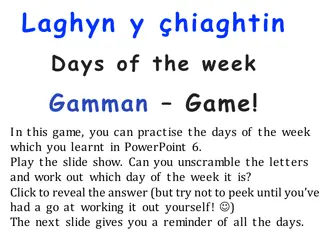
Algorithm Concepts in Interval Scheduling Problem
Explore the concept of interval scheduling problem in algorithms, where resources are allocated efficiently based on time intervals. Learn about greedy algorithms, sorting techniques, and efficient scheduling strategies.
Download Presentation

Please find below an Image/Link to download the presentation.
The content on the website is provided AS IS for your information and personal use only. It may not be sold, licensed, or shared on other websites without obtaining consent from the author. If you encounter any issues during the download, it is possible that the publisher has removed the file from their server.
You are allowed to download the files provided on this website for personal or commercial use, subject to the condition that they are used lawfully. All files are the property of their respective owners.
The content on the website is provided AS IS for your information and personal use only. It may not be sold, licensed, or shared on other websites without obtaining consent from the author.
E N D
Presentation Transcript
What did we talk about last time? Finished Master Theorem Solved exercises
An Arab sheikh tells his two sons to race their camels to a distant city to see who will inherit his fortune The one whose camel is slower wins After wandering aimlessly for days, the brothers ask a wise man for guidance Upon receiving the advice, they jump on the camels and race to the city as fast as they can What did the wise man say to them?
In the interval scheduling problem, some resource (a phone, a motorcycle, a toilet) can only be used by one person at a time People make requests to use the resource for a specific time interval [s, f] The goal is to schedule as many uses as possible There's no preference based on who or when the resource is used
Interval scheduling can be done with a greedy algorithm While there are still requests that are not in the compatible set Find the request r that ends earliest Add it to the compatible set Remove all requests q that overlap with r Return the compatible set
First, we sort the nrequests in order of finishing time The best comparison-based sort takes O(nlog n) We scan through the n sorted requests again and make an array S of length n such that S[i] contains the starting value of i, s(i) O(n) time Our algorithm selects the first interval in our list sorted on finishing time. We then move through array S until we find the first interval jsuch that s(j) the finishing time selected. We add it. We continue the process until we have moved through the entire array S. O(n) time Total time: O(nlog n)
Directed graph G= (V, E) with start node s Assume that there is a path from sto every other node (although that's not critical) Every edge ehas a length le 0 For a path P, length of P l(P) is the sum of the lengths of the edges on P We want to find the shortest path from sto every other node in the graph An undirected graph is an easy tweak
Let's first look at the lengthof the paths, not the actual paths We keep set Sof vertices to which we have determined the true shortest-path distance S is the explored part of the graph Then, we try to find the shortest new path by traveling from any node in the explored part Sto any node voutside We update the distance to vand add vto S Then, continue
Let Sbe the set of explored nodes For each u S, we store a distance d(u) Initially S= {s} and d(s)= 0 While S V Select a node v S with at least one edge from S for which d'(v) = mine=(u,v):u Sd(u) + leis as small as possible Add v to S and define d(v) = d'(v)
3 C 2 B 4 J 2 9 3 A 6 8 13 F 2 3 I 7 D H 4 17 3 4 G E 1
You can think of Breadth-First Search as a pulse expanding, layer by layer, through a graph from some starting node Dijkstra's algorithm is the same, except that the time it takes for the pulse to arrive is based not on the number of edges, but the lengths of the edges it has to pass through Because Dijkstra's algorithm expands from the starting point to whatever is closer, it grows like a blob There are algorithms that, under certain situations, can cleverly grow in the direction of the destination and will often take less time to find the path there
We have a weighted, connected graph and we want to remove as many edges as possible such that: The graph remains connected The edges we keep have the smallest total weight This is the minimum spanning tree (MST) problem We can imagine pruning down a communication network so that it's still connected but only with the cheapest amount of wire total MST algorithms are also used as subroutines in other graph problems
Assuming positive edge weights, the resulting graph is obviously a tree If the graph wasn't connected, it wouldn't be a solution to our problem If there was a cycle, we could remove an edge, make it cheaper, and still have connectivity
Kruskal's algorithm: Add edges to the MST in order of increasing cost unless it causes a cycle Prim's algorithm: Grow outward from a node, always adding the cheapest edge to a node that is not yet in the MST Backwards Kruskal's algorithm: Remove edges from the original graph in order of decreasing cost unless it disconnects the graph All three algorithms work!
8 7 B I A 4 D C 12 2 3 1 3 5 5 9 5 1 E 6 H 4 F G 2 11 5 10 4 9 1 J K L
Imagine you have a set of objects Photographs Documents Microorganisms You want to classify them into related groups Usually, you have some distance function that says how far away any two objects are You want to group together objects so that all the objects in a group are close
The distance function is usually defined between all points If the points are in the plane or another Euclidean space, the distance could simply be the distance between them A more flexible way to define distance is as weights on graph edges in a complete graph The distance between a point and itself is 0 The distance between any two distinct points is greater than 0 The distance between two points is symmetrical
What if we want to divide our objects into k non-empty sets: C1, C2, , Ck The spacing of this k-clustering is the minimum distance between any pair of points in different clusters We want to find clusters with maximum spacing There are other metrics to optimize your clusters on
We don't want to group together objects that are far apart We sort all of the edges by weight and begin adding them back to our graph in order If an edge connects nodes that are already in the same cluster, we skip it Thus, we don't make cycles We stop when we have k connected components
This algorithm is exactly Kruskal's algorithm Add edges by increasing size, skipping ones that make a cycle We simply stop when we have k connected components instead of connecting everything Alternatively, you can make the MST and delete the k 1 most expensive edges
We want to make an encoding such that the encoding of one letter is not a prefix of the coding of another letter Such an encoding is called a prefix code If you have a prefix code, you can scan bits from left to right and output a letter as soon as it matches Example prefix code: a 11 b 01 c 001 d 10 e 000
If each letter x has a frequency fx, with n letters total, nfx gives the number of occurrences of x in a document Let code(x) be the encoding of a letter x and S is the alphabet Total length of an encoding is: ???????(?) = ? ?????? ? ? ? ? ? An optimal prefix code minimizes average encoding length: ?????? ? ? ?
A key idea is that we can represent letters as leaves in a binary tree Each left turn is a 0 Each right turn is a 1 No letter will be the prefix of another Why? If a letter was the prefix of another, it would be on the path to the other letter, but every letter is a leaf
a 1 b 011 c 010 d 001 e 000 a e d c b
Recall that a binary tree is a rooted tree in which each node has 0, 1, or 2 children A full binary tree is one in which every node that isn't a leaf has two children
We know that the binary tree will be full, but there are many full binary trees with n leaves Imagine that we had a full binary tree T* that was an optimal prefix tree We know that the low frequency letters should appear at the deepest levels of the tree For letters y and z, and corresponding nodes node(y) and node(z), if depth(node(y)) < depth(node(z)) then fy fz.
If we did, we could label it by putting the highest frequency letters in the highest levels of the tree and then going down, level by level Instead, we work backwards The lowest frequency letter must be at the deepest leaf in the tree, call it v Since this is a full binary tree, v must have a sibling w
Take the two lowest frequency letters y and z. Since they are neighbors in a full tree, we can stick them together and treat them like a meta-letter yz with the sum of their frequencies. Recursively repeat until everything is merged together.
If S has two letters then Encode one with 0 and the other with 1 Else Let y and z be the two lowest-frequency letters Form a new alphabet S' by deleting y and z and replacing them with a new letter w of frequency fy + fz Recursively construct a prefix code for S' with tree T' Define a prefix code for S as follows: Start with T' Take the leaf labeled w and add two children below it labeled y and z
Divide and conquer algorithms are ones in which we divide a problem into parts and recursively solve each part Then, we do some work to combine the solutions to each part into a final solution Divide and conquer algorithms are often simple However, their running time can be challenging to compute because recursion is involved
If there are two elements in the array or fewer then Make sure they're in order Else Divide list into two halves Recursively merge sort the two halves Merge the two sorted halves together into the final list
The algorithm is simple, but recursive We'll use T(n) to describe the total running time recursively ? ? ?, ? 2 ? 2 ? ? 2? + ??, ? > 2 Is it really the same constant c for both? No, but it's an inequality, so we just take the bigger one
Each time, the recursion cuts the work in half while doubling the number of problems The total work at each level is thus always cn To go from n to 2, we have to cut the size in half (log2 n) 1 times cn cn cn cn/2 cn/2 cn cn/4 cn/4 cn/4 cn/4
Defining a sequence recursively as with Mergesort is called a recurrence relation The initial conditions give the starting point Example: Initial conditions T(0) = 1 T(1) = 2 Recurrence relation T(k) = T(k-1) + kT(k-2) + 1, for all integers k 2 Find T(2), T(3), and T(4)
We want to be able to turn recurrence relations into explicit formulas whenever possible Often, the simplest way is to find these formulas by iteration The technique of iteration relies on writing out many expansions of the recursive sequence and looking for patterns That's it
Intelligent pattern matching gets you a long way However, it is sometimes necessary to substitute in some known formula to simplify a series of terms Recall Geometric series: 1 + r + r2+ + rn = (rn+1 1)/(r 1) Arithmetic series: 1 + 2 + 3 + + n = n(n + 1)/2
We have seen that recurrence relations of the form ? ? 2? 2+ ??are bounded by O(n log n) What about ? ? ?? 2+ ??where q is bigger than 2 (more than two sub-problems)? There will still be log2n levels of recursion However, there will not be a consistent cn amount of work at each level ? ?
In general, it's log2? 1 log2? 1 ? ? ? 2 ? 2 ? ? ?? = ?? ?=0 ?=0 This is a geometric series, where ? =? 2 ?log2? 1 ? 1 ?log2? ? 1 ? ? ?? ??
?log2? 1 ? 1 ?log2? ? 1 ? ? ?? ?? Since r 1 is a constant, we can pull it out ? ? 1??log2? For ? > 1 and ? > 1, ?log ?= ?log ?, thus ?log2?= ?log2?= ?log2(?/2)= ?(log2?) 1 ? ? ? ?log2? ? ? ? ? ? 1? ?(log2?) 1 ? 1?log2? which is
What if we wanted to measure the similarity of one ranking to another ranking? Inversions are pairs of elements that are out of order in one ranking with respect to the other Formally, for indices i < j, there's an inversion if ranking ri > rj






















